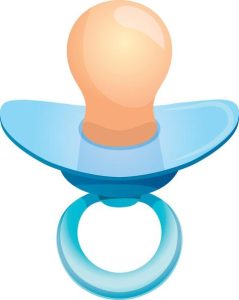Physical Address
304 North Cardinal St.
Dorchester Center, MA 02124
Physical Address
304 North Cardinal St.
Dorchester Center, MA 02124

Welcome to the wonderful world of parenthood! Newborn babies have many needs, and keeping them calm and comfortable is a top priority. Pacifiers can be a helpful tool for soothing fussy babies. This article explores the different types of pacifiers available, the benefits of using baby boy pacifiers for baby boys, and tips for safe pacifier use.
Important Note: The American Academy of Pediatrics (AAP) recommends exclusive breastfeeding for the first 6 months of life, followed by continued breastfeeding along with complementary foods for at least 1 year. If you are breastfeeding, consult with your pediatrician or lactation consultant to discuss pacifier use and potential impact on breastfeeding.
Pacifiers are objects that babies can suck on for non-nutritive sucking. They come in a variety of shapes, sizes, and materials. Here’s a breakdown of the different types:
Pacifiers come in orthodontic, cherry-shaped, and rounded nipples. Orthodontic nipples are designed to mimic the shape of a breast or bottle nipple, while cherry-shaped and rounded nipples are more traditional designs.
Pacifiers are typically made from silicone or latex. Silicone is a durable and long-lasting material, while latex is softer and more flexible.
The shield is the part of the pacifier that rests around the baby’s mouth. Shields come in vented and non-vented styles. Vented shields may help reduce the risk of skin irritation.
Some pacifiers have a handle that makes it easier for the baby to hold onto the pacifier.

Pacifiers can offer several benefits for both babies and parents:
Soothe fussiness: Sucking is a natural reflex for babies and can be calming. A pacifier can help soothe a fussy baby and promote relaxation.
Reduce pain: Sucking on a pacifier can help numb pain from teething or minor discomfort.
Promote sleep: Pacifiers can help babies fall asleep and stay asleep longer. This can be a lifesaver for sleep-deprived parents!
May reduce the risk of SIDS: Studies suggest that pacifier use may be linked to a reduced risk of Sudden Infant Death Syndrome (SIDS). However, it is important to follow safe sleep practices to further reduce the risk of SIDS.
Remember: The decision of whether or not to use a pacifier is a personal one. There are both benefits and drawbacks to consider. Talk to your pediatrician about what’s right for you and your baby boy.

With so many pacifiers on the market, it can be overwhelming to choose one. Here are some factors to consider:
Your baby’s preference: Some babies will take to any pacifier, while others may be picky. Experiment with different types to see which one your baby likes best.
Your baby’s age: Newborn babies may need a smaller pacifier than older babies.
Material: Silicone pacifiers are generally more durable than latex pacifiers. However, latex pacifiers may be softer and more comfortable for some babies.
Safety: Always choose a pacifier that is BPA-free and meets current safety standards.
Here are some important tips for safe pacifier use:
Never tie a pacifier to a string or ribbon: This can be a choking hazard.
Don’t force a pacifier on your baby: If your baby doesn’t want the pacifier, don’t force it.
Replace pacifiers regularly: Inspect pacifiers for signs of wear and tear and replace them every few months.
Don’t coat the pacifier in sweet substances: This can lead to cavities and ear infections.
Store pacifiers in a clean container: This will help prevent the spread of germs.

Pacifiers can be a helpful tool for soothing and comforting your baby boy. By understanding the different types of pacifiers available, the benefits of pacifier use, and following safe use tips, you can make an informed decision about whether or not to use a pacifier for your baby.
Pacifiers can become part of your daily routine with your baby boy. Here are some tips for incorporating them and navigating potential challenges:
Offer the pacifier strategically: Try offering a pacifier when your baby boy shows early signs of fussiness, such as lip smacking or sucking on their hands. This can help nip fussiness in the bud before it escalates.
Develop a pacifier routine: You can use pacifiers for cues like car rides or nap time. Consistency can help your baby boy associate the pacifier with calming activities.
Be patient with pacifier acceptance: It may take some time for your baby boy to warm up to a pacifier. Keep offering it gently and see if they become interested over time.
Limit nighttime pacifier dependence: While pacifiers can be a sleep aid, some parents choose to wean their baby boy off the pacifier at night to promote longer stretches of sleep. Talk to your pediatrician for guidance on sleep training and pacifier weaning.

If you decide not to use a pacifier, or if your baby boy rejects them, here are some alternative soothing techniques:
Skin-to-skin contact: Holding your baby boy close can be very calming. Try kangaroo care, where you hold your baby skin-to-skin on your chest.
Sucking on a finger: Sucking is a natural reflex for babies and can be self-soothing. However, be mindful of prolonged thumb or finger sucking that can cause dental issues later on.
Movement: Rocking, swinging, or taking a walk in the stroller can all be calming for babies.
Shushing and white noise: The rhythmic sound of shushing or white noise can be very soothing for newborns.

The most important thing is to find what works best for you and your baby boy. There’s no right or wrong answer when it comes to pacifiers. Some babies find comfort in them, while others don’t. Be patient, experiment with different soothing techniques, and talk to your pediatrician for guidance. Remember, the most important thing is to find what works best for you and your baby boy. By following these tips and talking to your pediatrician, you can make informed decisions about pacifier use and keep your little one safe and healthy.